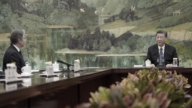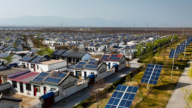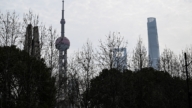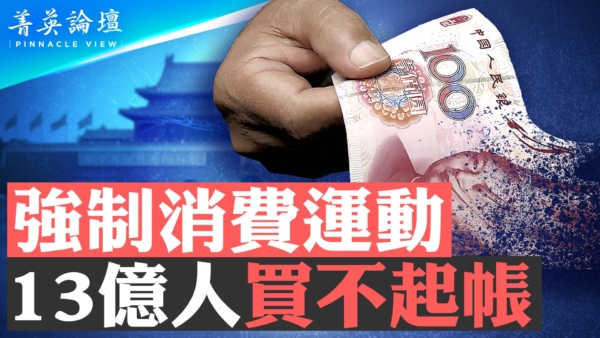【新唐人2011年7月2日讯】中国大陆持续通膨引发的高物价令公众不满,而网友微博发布的中美消费及物价对比更令人诧异:在美国消费和购买产品比中国还要便宜的多!这条帖文流传甚广并引起广泛的共鸣。学者表示,中国比美国物价高的根本原因是由中共的货币政策、高税收政策和内部的高通膨所致。
这条微博写道:中国,工资5,000元,吃一次肯德基30元,下一次馆子最少100元,买条Levis牛仔裤400元,买辆车最少30,000元——夏利﹔美国,工资5,000美元,吃一次肯德基4美元,下一次馆子40美元,买条Levis牛仔裤20美元,买辆车最多30,000美元——宝马。
旅美经济学家简天伦表示,货币政策和财政政策是导致中国商品价格比美国贵的主要原因。
简天伦:“卖地也好、投资也好,大量货币供应低估人民币,这三个都可以知道中国的货币发行量来源在哪里,为什么市场上那么有钱,所以价格就必然高。归结起来,这三个政策是推高价格的一个原因。”
简天伦表示,随着大量投资、银行贷款的急速增长,市场上货币量也大量增加﹔加上近年来地方的土地财政,出售土地占据GDP总量的1/3以上,地方政府贷款大量增加,2010年底,地方政府债务已达到10.7万亿﹔另外,国家以出口拉动内需为战略、低估人民币的方针,导致外汇大量增加,因此,致使人民币发放大量增加。简天伦说,现在中国货币供应量已经超过美国,成为世界第一。
而经济时政评论家草庵居士认为,中国印的钞票越来越多,人民币越来越多,通货膨胀会越严重,所以中国经济发展不可持续性。
草庵居士:“所以你看到中国发展经济不要以为现在中国经济很好,你看到好是因为把全国百姓的财富政府拿到手里头,但实际上内部是靠通货膨胀的,因为它的钞票印的越来越多,而且物资越来越少,这是一个恶性循环。在这种情况下中国现在给大家看到我们在美国的物价相反要比中国便宜。”
去年,大陆知名财经评论人士时寒冰到美国旅行,特别对中美物价的差别进行了半个月的走访,时寒冰最终的调查结果是:除非涉及到人工服务,比如理发,或涉及智慧财产权的图书音像外,美国商品的价格普遍低于国内,比中国便宜50%以上,而美国的人均收入是中国的34倍。
时寒冰在他的博客表示,GDP远不及美国的中国,同样的商品在中国所对应的货币量,远远大于在美国所对应的货币量!关于这点,简天伦认为,高税收的财政政策是另一个主要原因。
简天伦:“中国20年来 GDP增长很高,但是财政更高,都在20%以上的增长速度,自然是税收非常高。虽然中国生产的产品(价格)并不一定贵,但是中国的财政税收太厉害了,把成本完全提上去了,最终端的价格里面,50%甚至70%都跟税收有关。这就解释了为什么中国制造的产品在中国反而比美国贵得多。
依据国际货币基金组织《政府财政统计年鉴(2007)》公布的2006年资料计算,中国商品中所含的税比任何一个发达国家都高:是美国的4.17倍,是日本的3.76倍,是欧盟15国的2.33倍。
新唐人记者高紫檀、宋风、孙宁采访报导。
Why Prices in China are higher than in U.S.
The public is discontent with the inflation in China.
It is even more surprising to the Chinese that
many consumer goods are cheaper in the U.S.
Scholars say that the higher prices in China
were caused by Chinese Communist Party’s (CCP)
monetary policy, tax policy and high internal inflation.
A blog reveals that, with a salary of RMB 5,000
it costs RMB 30 to have a meal at KFC in China,
over RMB 100 for a meal in a restaurant,
RMB 400 for a pair of Levi’s jeans,
and over RMB 30,000 for the cheapest car Xiali.
In the U.S., with a salary of USD 5,000,
it costs 4 dollars for a KFC meal,
40 dollars for a meal in a restaurant,
20 dollars for a pair of Levi’s jeans,
and less than USD 30,000 for a BMW.
U.S.-based Economist Jian Tianlun said the differences
are caused by China’s monetary and fiscal policies.
Jian Tianlun: Due to land sales, investments
and a large monetary supply, RMB deprecates,
and China’s currency issuance volume is large.
The large monetary supply caused price increases.
Jian says that with lots of investments,
and the rapid growth of bank loans,
the monetary supply dramatically increases.
Combined with the recent regional land finances,
land sales account for a third of China’s GDP.
Regional government debts increased drastically
and reached RMB 10.7 trillion by the end of 2010.
Also, the current policy of stimulating domestic demand
by exports and of keeping the RMB exchange rate low.
It caused a large increase in foreign exchange reserve,
which in turn increased China’s monetary supply.
Jian says China’s money supply ranks the first globally.
Economic Critic Caoan Jushi believes that
as China keeps on printing more and more bills,
it makes the inflation more serious. Therefore,
China’s economic development is not sustainable.
Caoan Jushi: China’s economic development seems
to be good, but it is not the case.
The government robs the people’s money.
There is a high internal inflation.
As more bills are printed, with diminishing goods,
it forms a vicious circle. As a result,
product prices are higher in China than in the U.S.
Chinese financial critic Shi Hanbing made a trip
to the U.S. to compare the price differences.
His conclusion is that except for services and
intellectual property-related products,
goods in the U.S. are 50% cheaper than in China.
However, U.S. per capita income is 34 times
of the per capita income in China.
Shi blogged that China has a lower GDP than the U.S.
However, more money is needed in China
to buy the same products than in the U.S.
Jian attributes this to high-tax fiscal policy in China.
Jian: China had a high GDP growth rate in last 20 years.
However, it had a higher fiscal budge growth rate
of at least 20%. As a result, the tax rate became high.
The goods made in China may not be expensive,
but the taxes imposed increase their prices drastically.
50~70% of the end price is related to taxes.
This explains why Chinese-made products
have higher prices in China than in the U.S.
Data from the IMF Government Finance Statistic
shows that (based on data in 2006)
China had the large portion of tax as part of the price.
It is 4.17 times of the U.S. figure,
3.76 times of the Japanese figure
and 2.33 times of the 15 E.U. countries.
NTD reporters Gao Zitan,Song Feng and Sun Ning




























